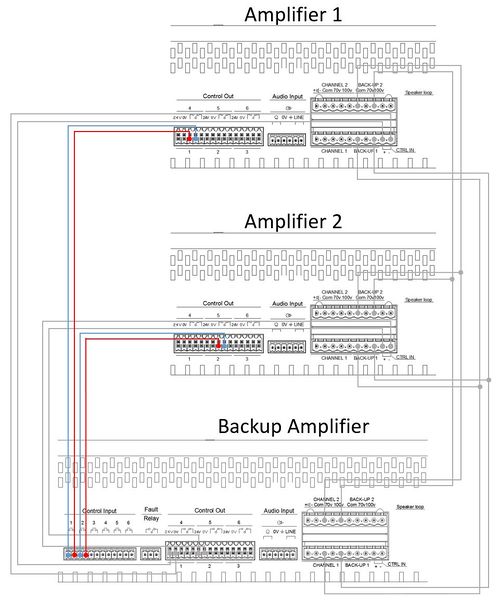Difference between revisions of "Backup Amplifier Wiring"
(→Standard backup wiring example) |
(Tag: Visual edit) |
||
| Line 5: | Line 5: | ||
The backup amplifier needs to be wired to the amplifier(s) it should monitor: | The backup amplifier needs to be wired to the amplifier(s) it should monitor: | ||
* One control output (24V DC) from the backup amplifier is connected to each of the backed up amplifiers (star wiring). | * One control output (24V DC) from the backup amplifier is connected to each of the backed up amplifiers (star wiring). | ||
| − | * The speaker loop outputs from the backup amplifier | + | * The speaker loop outputs from the backup amplifier are connected to the backup inputs on all amplifiers being backed up (bus wiring). |
In addition, an optional function on a control input on the backup amplifier can trigger the backup functionality. | In addition, an optional function on a control input on the backup amplifier can trigger the backup functionality. | ||
| − | This will ensure an even faster switch-over if the | + | This will ensure an even faster switch-over if the defective amplifier has a power issue. |
* Wire the Control Output on the backed up amplifier to the Control Input on the backup amplifier. | * Wire the Control Output on the backed up amplifier to the Control Input on the backup amplifier. | ||
| − | ==Standard | + | ==Standard Backup Wiring Example== |
In the pictures below we have a backup amplifier that is hot standby for two amplifiers. | In the pictures below we have a backup amplifier that is hot standby for two amplifiers. | ||
Revision as of 13:23, 12 December 2016
This article describes how to wire the backup amplifier solution. Exigo ENA Amplifiers have inbuilt support for backup amplifier switch-over where one amplifier can be designated as backup for up to six other amplifiers.
Wiring
The backup amplifier needs to be wired to the amplifier(s) it should monitor:
- One control output (24V DC) from the backup amplifier is connected to each of the backed up amplifiers (star wiring).
- The speaker loop outputs from the backup amplifier are connected to the backup inputs on all amplifiers being backed up (bus wiring).
In addition, an optional function on a control input on the backup amplifier can trigger the backup functionality. This will ensure an even faster switch-over if the defective amplifier has a power issue.
- Wire the Control Output on the backed up amplifier to the Control Input on the backup amplifier.
Standard Backup Wiring Example
In the pictures below we have a backup amplifier that is hot standby for two amplifiers.
Control output/input wiring:
The red and blue wiring is the control outputs from the backup amplifier to the two backed up amplifiers:
- Control output 1 (24V DC) on the Backup Amplifier is wired to the control in (labeled CTRL IN) on Amplifier 1.
- Control output 2 (24V DC) on the Backup Amplifier is wired to the control in (labeled CTRL IN) on Amplifier 2.
Speaker output/input wiring:
The orange and green wire is the 100V speaker lines:
- Channel 1 output on the Backup Amplifier is wired to channel 1 backup input (labeled BACK-UP 1) on Amplifier 1 and Amplifier 2.
- Channel 2 output on the Backup Amplifier is wired to Channel 2 backup input (labeled BACK-UP 2) on Amplifier 1 and Amplifier 2.
Optional switch-over wiring example
The picture below describes how the optional switch-over wiring is done.
The red and blue wiring is the control outputs from the backed up amplifiers to the backup amplifiers:
- Control Output 1 (NO - Normally Open) on Amplifier 1 is wired to the Control Input 1 on the Backup Amplifier.
- Control Output 2 (NO - Normally Open) on Amplifier 2 is wired to the Control Input 2 on the Backup Amplifier.
Please be aware that the standard backup wiring also must be done to make the optional switch-over work.

